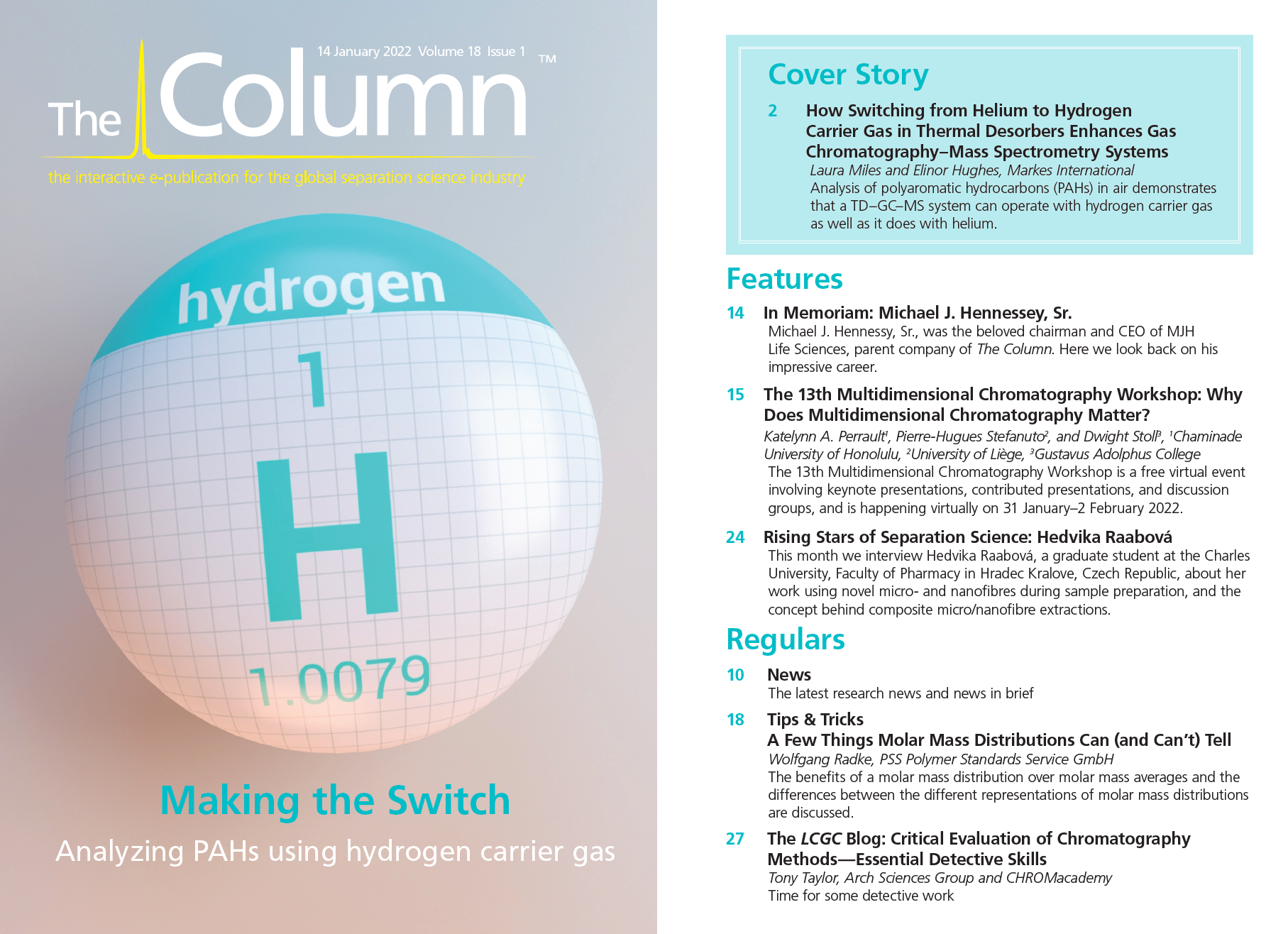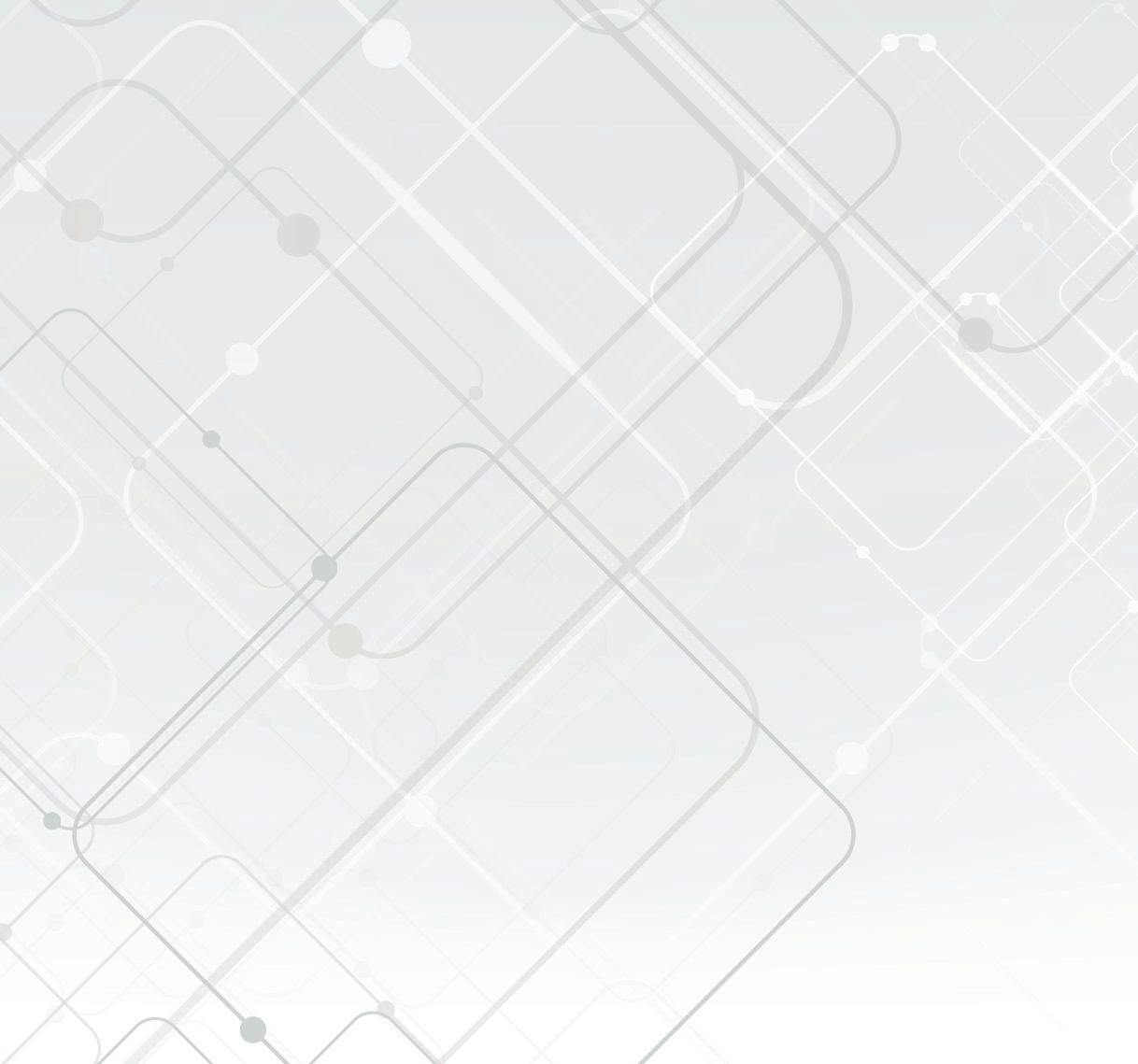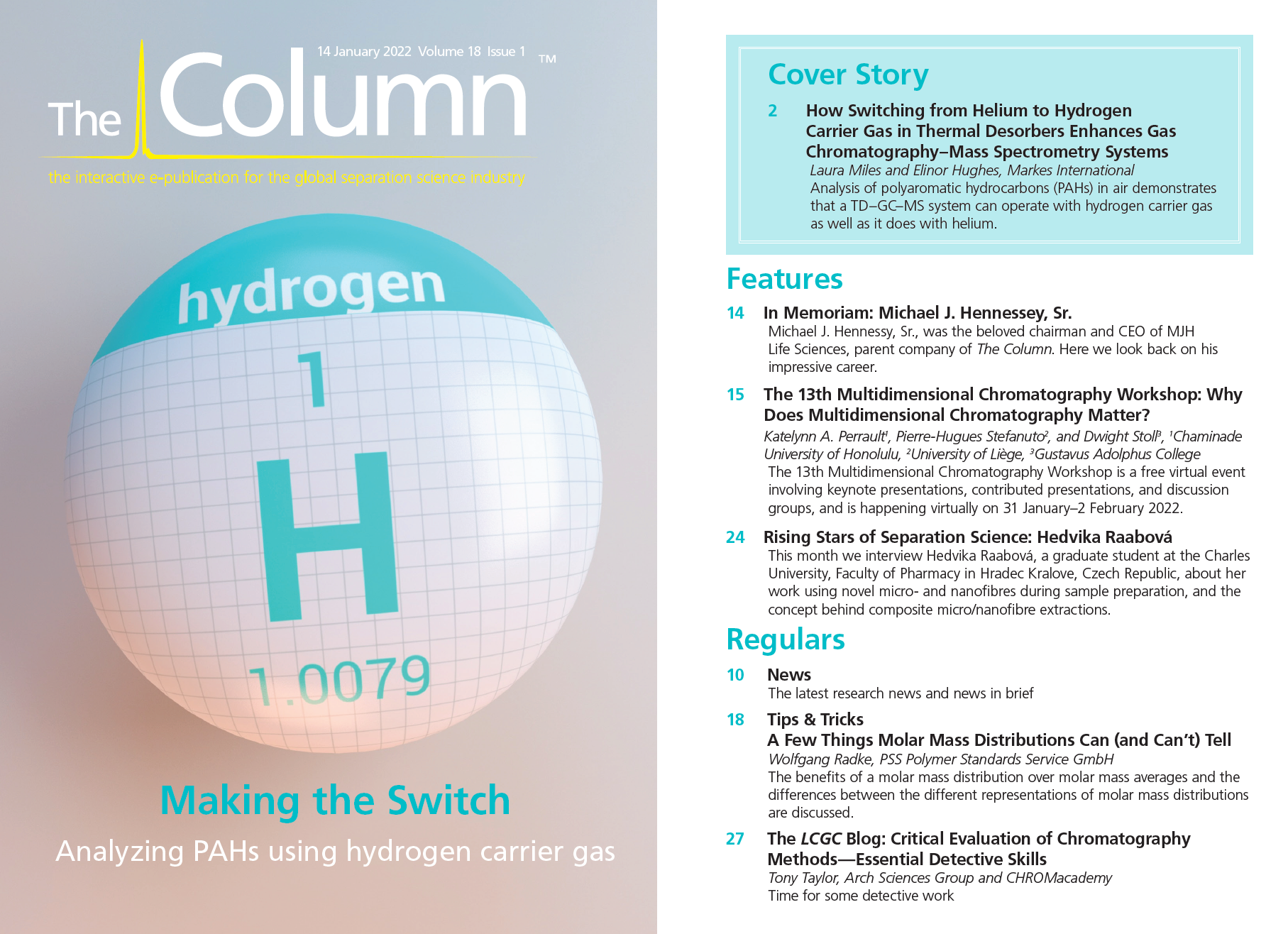The 13th Multidimensional Chromatography Workshop: Why Does Multidimensional Chromatography Matter?
The 13th Multidimensional Chromatography Workshop is a free event involving keynote presentations, contributed presentations, and discussion groups on all multidimensional techniques, and is happening virtually on 31 January–2 February 2022. The workshop welcomes both experts and new users to the field for training, networking, and sharing the latest trends. Keynote lecturers will present on major trends in both multidimensional gas chromatography (GC) and multidimensional liquid chromatography (LC), from the point of view of both academic and industry research.
Participants will be able to choose from several focus group discussions intended to stimulate discussion on key areas of the field. The full programme has been released and indicates concurrent sessions on popular topics including modulation technologies and data analysis. The programme will also include concurrent poster sessions on different application areas. Presenters will be eligible for three poster awards:
- Multidimensional GC Poster Award—Sponsored by the American Chemical Society’s Subdivision on Separations Chemistry and Chromatography—$250 USD Student Award
- Multidimensional LC Poster Award—Sponsored by the American Chemical Society’s Subdivision on Separations Chemistry and Chromatography—$250 USD Student Award
- Industrial Research and Development Poster Award—Sponsored by CerTech—€250
Keynote Lectures
This year, the workshop will highlight the work of four keynote speakers. The speakers come to us with experience in either multidimensional gas chromatography (GC) or multidimensional liquid chromatography (LC), and they represent both academic research and industry sectors. In addition, we have asked all the keynote speakers to address the following questions in their presentations to get their perspective on the evolution of multidimensional chromatography:
- What sparked your interest in multidimensional chromatography?
- What was the moment you were convinced that multidimensional chromatography was a valuable solution to adopt?
- What is the biggest challenge facing the field of multidimensional chromatography?
- What is the most interesting application of multidimensional chromatography you have seen in the last year?
- Why does multidimensional chromatography matter?
Robert E. Synovec, Professor, University of Washington
Implementation of Tile-Based Fisher Ratio Analysis with GC×GC–TOF-MS Datasets: Current Status and Future Prospect
Robert E. Synovec is Professor of Chemistry at the University of Washington (UW) in Seattle (Washington, USA). He obtained his Ph.D. in 1986 from Iowa State University, and then joined the UW faculty that year. He served as Associate Chair of the Chemistry Graduate Education Programme from 2007–2020. Synovec has graduated 45 PhDs, 4 thesis masters, and 8 non-thesis masters students, with 10 postdocs and 60 undergraduate researchers. His group pioneers the development of novel analytical instrumentation and methodology based upon chemical separation science coupled with chemometric data analysis. The group investigates the basic principles of separation science, detection, and data analysis at both a fundamental and problem-solving level. He has over 270 publications and over 620 research presentations, which includes over 250 invited lectures and invited presentations. In May 2013, Synovec was awarded the GC×GC Scientific Achievement Award at the 10th GC×GC International Symposium. This award has been instituted to recognize the pioneering contributions of key scientists in promoting GC×GC instrumentation, method development, and/or applications. In May 2016, Synovec received the Marcel Golay Award at the 40th ISCC meeting in Riva del Garda, Italy, which is presented annually to a scientist in recognition
of a lifetime of achievement in capillary chromatography.
Petr Česla, Associate Professor, University of Pardubice
Optimization of Microcolumn Two‑Dimensional LC—Towards Highly Sensitive Separation
Methods
Petr Česla is Associate Professor of Analytical Chemistry at the Department of Analytical Chemistry, Faculty of Chemical Technology, University of Pardubice. His research work focuses on the development of separation techniques in the liquid phase, mainly LC and capillary electrophoresis (CE), with special attention on two-dimensional separations, optimization procedures, data processing, and coupling of LC and CE to mass spectrometry (MS). He has been engaged in many research projects and acts as Principal Investigator for several projects for the Czech Science Foundation. He is author of more than 45 papers in scientific journals with 850 citations, and co-author of one book and two book chapters. He was supervisor of 20 diploma and 14 bachelor theses and currently supervises three Ph.D. students.
Melissa Dunkle, Research Scientist, Dow Benelux BV
Implementing GC×GC for Industrial Applications: The Good, The Bad, and The Ugly
Melissa received her Ph.D. degree in 2007 under the direction of Luis A. Colón from the Department of Chemistry at the University at Buffalo, New York, USA. She then completed a two year postdoc at Ghent University in Belgium under the direction of Pat Sandra. In 2009, Melissa accepted a role as GC Specialist at the Research Institute for Chromatography (RIC) in Kortrijk; she then joined Dow Benelux BV in 2015 in Analytical Science, Core R&D.Her expertise includes liquid chromatography–high‑resolution mass spectrometry (LC–HRMS, MS/MS), gas chromatography coupled to various detector technologies (GC–flame ionization detection [FID], GC–MS, GC–[HR] time‑of‑flight [TOF]‑MS, GC–vacuum ultraviolet [VUV]), supercritical fluid chromatography (SFC), and multidimensional chromatography (LC×LC and GC×GC). In her current role, Melissa leads various research projects to advance analytical capabilities and improve the evaluation of natural gas and circular feedstocks.
Alexandre Goyon, Senior Scientist, Genentech
2D-LC Analysis of Oligonucleotides: From Their Conventional Analysis at the Intact Level to an Integrated Bottom-Up Approach
Alexandre Goyon is Senior Scientist in the Genentech Research and Early Development (gRED) organization. He received a Ph.D. degree in pharmaceutical analytical chemistry in 2019 from the University of Geneva, Switzerland. He has published 32 peer‑reviewed papers and he is the first author of 19 of them. His team supports early- and late-stage research.
Focus Groups
This year, the workshop will host small focus groups to discuss the landscape of three narrower topics appearing to gain attention in the field of multidimensional chromatography. Attendees will choose one of the sessions to attend and contribute to the discussion. This will also be an opportunity for individuals to interact more easily in smaller groups to learn more about certain topics or to contribute their expert opinions. Focus groups will be moderated by experts in multidimensional separations to lead the conversation.
Topic 1: Simultaneous Detection: Who is doing it? What are the combinations being used? What are the benefits? What are the drawbacks? What is the difference in how they are used most commonly for multidimensional GC vs. multidimensional LC?
Topic 2: Optimization: How do you optimize your separation? Who is performing full optimization for every study? Are users moving towards a standard column set for various applications? Do newcomers need to know how to do robust optimization to get started?
Topic 3: External Software and Freeware Options: Who is using
freeware written using languages such as R or Python? What part of data processing can be done in these programs? What are the pros and cons of using freeware (validation, standardization)? What are the benefits and drawbacks of external software vs. embedded approaches being developed?
Final Comments
In preparing for the conference, we released a survey to ask participants—why does multidimensional chromatography matter? We hope to understand this question in greater detail at the end of the conference, but so far, respondents felt that multidimensional chromatography was helpful to:
- Uncover the hidden contents of a sample;
- Diversify the tools they are able to use to solve chemical problems;
- Find what is unknown in the most complex samples.
Registration is completely free of charge and can be completed at www.multidimensionalchromatography.com. We hope that you will join us for this exciting event, whether you are looking to find out what multidimensional chromatography is all about, looking to improve your skills in multidimensional separations, or hoping to improve your network in the field of multidimensional chromatography.
Katelynn A. Perrault is at Chaminade University of Honolulu, Hawaii.
Pierre-Hugues Stefanuto is at University of Liège, Belgium.
Dwight Stoll is at Gustavus Adolphus College, St. Peter, Minnesota, USA.
Website: www.multidimensionalchromatography.com

Understanding FDA Recommendations for N-Nitrosamine Impurity Levels
April 17th 2025We spoke with Josh Hoerner, general manager of Purisys, which specializes in a small volume custom synthesis and specialized controlled substance manufacturing, to gain his perspective on FDA’s recommendations for acceptable intake limits for N-nitrosamine impurities.















